

Examples of their work:

Robert Henri (born Robert Henry Cozad) (American, 1865-1929), The Laundress, c. 1910, oil on canvas, Phoenix Art Museum, AZ.
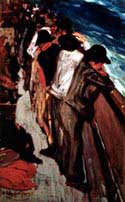
George Benjamin Luks (American, 1866-1933), In the Steerage, 1900, oil on canvas, 30 5/8 x 19 1/4 inches (77.8 x 48.9 cm), North Carolina Art Museum, Raleigh.
Alfred Henry Maurer (American, 1868-1932)
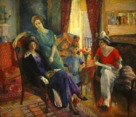
William Glackens (American, 1870-1938), Family Group, 1910 or 1911, oil
on canvas, 72 x 84 inches,
National Gallery of Art, Washington, DC. This was exhibited in
the influential Armory Show of 1913.
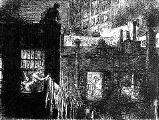
John Sloan (American, 1871-1951), Night
Windows, 1910, etching,
5 1/4 x 7 inches. This was exhibited in the influential Armory
Show of 1913.
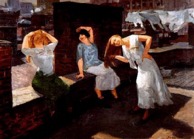
John Sloan, Sunday, Women Drying Their Hair, 1912,
oil on canvas,
25 1/2 x 31 1/2 inches, Addison Gallery of American Art, Phillips
Academy, Andover, MA. This too was exhibited in the influential
Armory Show of 1913.
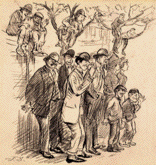
John Sloan, 1912, "Tee
Hee" Boys: Born with a Vote and a Partial Sense of the Ridiculous,
1912, ink and crayon,
published in Collier's, May 18, 1912, as "Aw, Susie, be
them dishes washed?" Library of Congress, Washington, DC.
This crowd watches and jeers as a parade of suffragettes parade
past. Suffragettes were women who campaigned for the right to
vote.
John Sloan, Nude, Pink Striped Coverlet, 1927, 13 1/2 X 15 inches, oil on canvas, Butler Institute of American Art, Youngstown, OH.
Everett Shinn (American, 1876-1953), Dancer in White Before the Footlights, 1910, oil on canvas, 35 x 39 inches, Butler Institute of American Art, Youngstown, OH.

George Wesley Bellows (American, 1882-1925),
Steaming Streets, 1908, oil
on canvas, 38 3/8 x 30
1/4 inches (97.5 x 76.8 cm), Santa Barbara Museum of Art, CA.
See painterly.

George Wesley Bellows (American, 1882-1925),
Stag at Sharkey's, 1909, oil
on canvas, 36 1/4 x 48
1/4 inches (92 x 122.6 cm), Cleveland Museum of Art. See diagonal.

George Wesley Bellows, Cliff Dwellers, 1913, oil
on canvas, 40 1/8 x 42
inches (101.9 x 106.7 cm), Los Angeles County Museum of Art.

George Wesley Bellows, Mrs. T in Cream Silk, No.2, 1920, oil on canvas,
53 x 43 inches, Minneapolis Institute of Arts.
![]()

George Wesley Bellows, The White Horse, 1922, oil
on canvas, Worcester Art
Museum, MA.
![]()
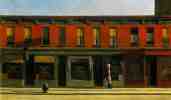
Edward Hopper (American, 1882-1967), Early Sunday Morning, 1930, oil on canvas, 35 3/16 x 60 1/4 inches (89.4 x 153 cm), Whitney Museum of American Art, NY. See American Scene painting and rectangle.
Also see American Scene painting.
https://inform.quest/_art
Copyright © 1996-![]()